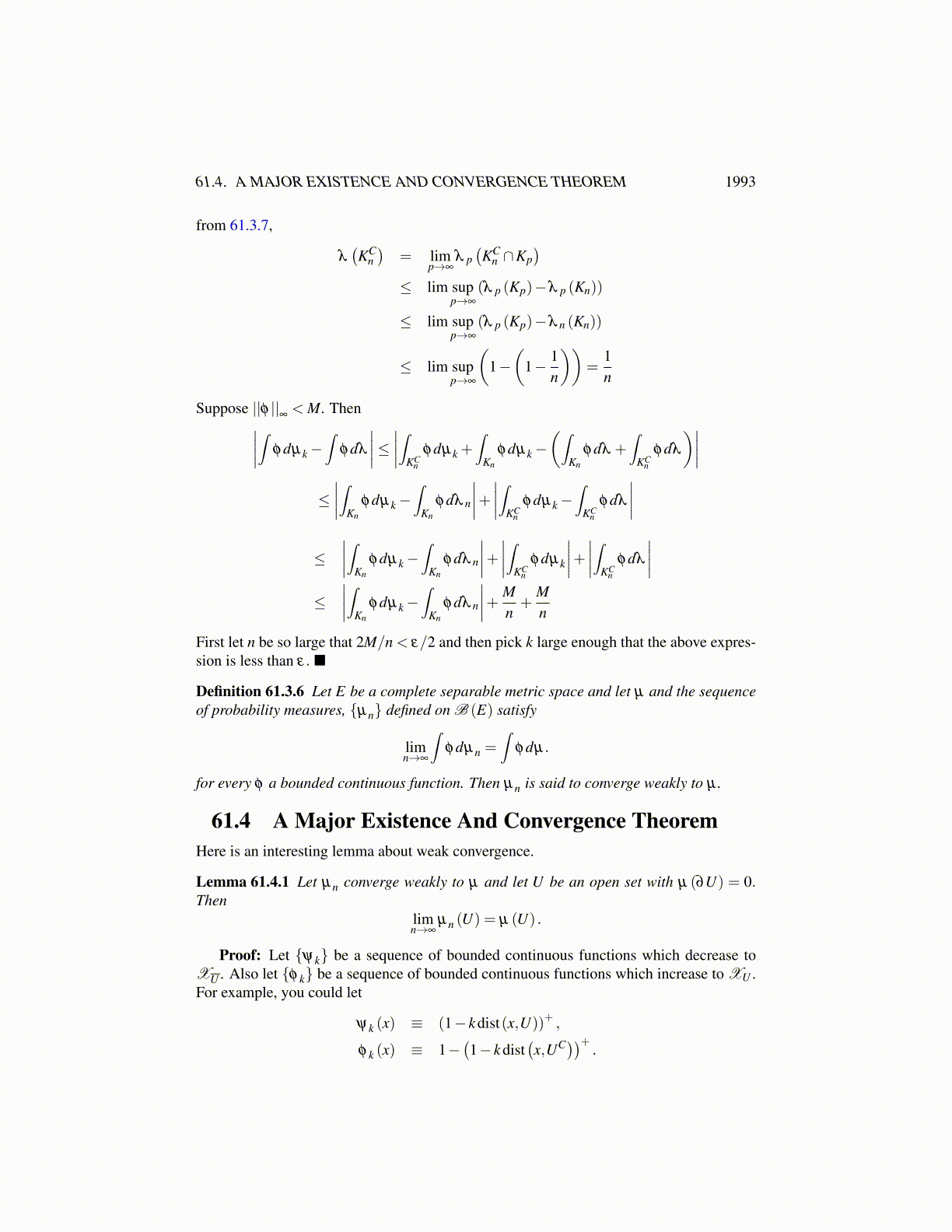
61.3. TIGHT MEASURES 1993
Proof: By tightness, there exists an increasing sequence of compact sets, {Kn} suchthat
µ (Kn)> 1− 1n
for all µ ∈ Λ. Now letting µ ∈ Λ and φ ∈C (Kn) such that ||φ ||∞≤ 1, it follows∣∣∣∣∫Kn
φdµ
∣∣∣∣≤ µ (Kn)≤ 1
and so the restrictions of the measures of Λ to Kn are contained in the unit ball of C (Kn)′ .
Recall from the Riesz representation theorem, the dual space of C (Kn) is a space of com-plex Borel measures. Theorem 17.5.5 on Page 462 implies the unit ball of C (Kn)
′ is weak∗ sequentially compact. This follows from the observation that C (Kn) is separable whichis proved in Corollary 61.3.4 and leads to the fact that the unit ball in C (Kn)
′ is actuallymetrizable by Theorem 17.5.5 on Page 462. Therefore, there exists a subsequence of Λ,{µ1k} such that their restrictions to K1 converge weak ∗ to a measure, λ 1 ∈C (K1)
′. Thatis, for every φ ∈C (K1) ,
limk→∞
∫K1
φdµ1k =∫
K1
φdλ 1
By the same reasoning, there exists a further subsequence {µ2k} such that the restrictionsof these measures to K2 converge weak ∗ to a measure λ 2 ∈ C (K2)
′ etc. Continuing thisway,
µ11,µ12,µ13, · · · → Weak∗ in C (K1)′
µ21,µ22,µ23, · · · → Weak∗ in C (K2)′
µ31,µ32,µ33, · · · → Weak∗ in C (K3)′
...
Here the jth sequence is a subsequence of the ( j−1)th. Let λ n denote the measure inC (Kn)
′ to which the sequence {µnk}∞
k=1 converges weak∗. Let {µn} ≡ {µnn} , the diag-onal sequence. Thus this sequence is ultimately a subsequence of every one of the abovesequences and so µn converges weak∗ in C (Km)
′ to λ m for each m. Note that this is allhappening on different sets so there is no contradiction with something converging to twodifferent things.
Claim: For p > n, the restriction of λ p to the Borel sets of Kn equals λ n.Proof of claim: Let H be a compact subset of Kn. Then there are sets, Vl open in Kn
which are decreasing and whose intersection equals H. This follows because this is a metricspace. Then let H ≺ φ l ≺Vl . It follows
λ n (Vl) ≥∫
Kn
φ ldλ n = limk→∞
∫Kn
φ ldµk
= limk→∞
∫Kp
φ ldµk =∫
Kp
φ ldλ p ≥ λ p (H) .
Now considering the ends of this inequality, let l→ ∞ and pass to the limit to conclude
λ n (H)≥ λ p (H) .